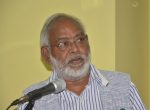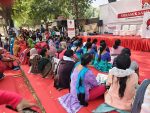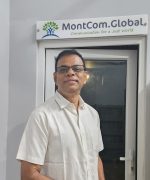By Rajiv Theodore
New Delhi, October 20, 2019: The majestic 16th century Humayun Tomb complex in the Indian capital came alive as raconteurs from across the globe converged to resurrect the dying art of story -telling.
Christened, Kathakar 2019– it is today India’s only and increasingly popular annual storytelling festival for three-enchanting nights under a star-lit wintry sky.
It was but a mesmerizing start with chants from Grammy Award winning Buddhist monks of the PalpungSherabling Monastery in Keori district of Himachal.
The monastery is the seat of the Tai Situ Rinpoche, a renowned Buddhist monk of the Karma Kagyu sect and their chants are oral traditions preserved from the 7th century.
“These sacred chants survived due to their oral traditions which had originated in the monasteries,” a monk explained but did not want to be named. These prayers in the form of chants are observed at the beginning and end of the day at the Sherabling monastery.
Elfish, with a long flowing beard, Uncle Larry Walsh connected and bonded with the audience as the world renowned, celebrated story-teller, who is the member of the Tauragurong aboriginal tribe of Australia underlined the fact that the oral story is an important expression and make-up of the aboriginal culture.
He impressed upon the fact that he wants to make communities especially aboriginals to be stronger. “Aboriginal people must live as much in the modern world as intimately connected to their past,’’ Uncle Walsh who spoke to Matters India said as he enthralled the audience with his inimical style of weaving a story replete with the sounds of the animals found in his native outback.
“Many of the stories that I relay here, especially of the Duck Bill Platypus and others are almost 25,000 years old or even older, the 65-year veteran raconteur said. Stroking his white beard, Uncle Larry explained that the aborigines have been scared in their own country before the 1967 referendum.
“We used to tell our stories only after dark as we were scared (of white reprisals).’’ It was on 27 May 1967 that Australians voted in favour of changes to the Australian Constitution to improve the services available to the indigenous Australians. ‘’ They took our land, they took our water but I will not allow them to take our stories’’, Uncle Larry said half in jest.
Vergine Gulbenkian from the UK narrated the tale of the burning kindled by a 16th century Caucasian love-epic and her interest in her family stories. Vergine, of Armenian descent is a Craniovascular Therapist and a story teller based in London.
(The Craniovascular Therapy is a specific non-invasive touch that helps the body’s innate ability to heal.) She also works with museums and exudes sheer joy while telling and listening to stories. Her interests led her to research the rich Armenian oral traditions especially about Ashiq, an epic singing and ballad (Dastaan) renditions dating back to 16th century.
There was an anchor of gravitas as Indian performer Danish Hussain kept his stories rooted and at once bonded with the crowd, as the award winning actor, poet and theatre director instrumental in reviving the lost art form of Urdu storytelling Dastangoi went on a narrative spree (in Urdu)sending everyone into raptures.
His tales may be about age old characters from the pages of history whose tales of valour are the stuff of legend, but Husain makes them entertaining and oddly applicable to real life too. Husain learned hands-on from some of India’s greatest creative and literary stalwarts like Habib Tanvir, MS Sathyu, Rajinder Nath and Sabina Mehta Jaitly.
From theatre, Husain graduated to Dastangoi – the ancient Urdu storytelling tradition – which experienced a wave of revival a few years ago, and for which he received a joint Sangeet Natak Akademi award with Mahmood Farooqui. Then, in 2012, he set up The Hoshruba Repertory, a performance company that, among other things, has introduced the world to Qissebaazi.Derived from Dastangoi, Qissebaazi – or the playful telling of stories – is different in that it doesn’t remain limited to Urdu but has opened up the possibility of integrating storytelling in various Indian languages. “The idea is to have stories in every language,” says Husain.
Emily Hennessey (previously Emily Parrish) who is a performance storyteller, tells myths, legends, epics, folktales, fairytales and fables from around the world, from the Hindu epic, the Ramayana to African Anansi stories. With a Swedish background, Emily also loves to tell Scandinavian folktales and Norse mythology. Hennessey said that she is dedicated to exploring the ancient art of storytelling as oral tradition within a contemporary context.
The youthful Jerzy Szufa from Poland who caught the fancy of the crowd with his narration of Polish tales that was accompanied by the occasional strumming from his harp. ‘’I am passionate about the art of storytelling of fairy tales and legends,’’. Szufa recalled that he had completed an international course on ‘’ share the right story’’ on the use of storytelling in education and said he had been directly influenced by eminent storytellers such as Jihad Darviche and Dan Yashinsky. ‘’ Back home, almost on a daily basis I work as an educator at the Royal Lazienksi Museum, (Warsaw) and organise author’s story art workshops for both the adults and children,’’ he said while explaining his motivated lifestyle to Matters India.
It was Imtiaz Ali who stole the show and many hearts as the lanky film director also showed his facet as a master storyteller. According to him there’s no façade, it is all genuineness in stories. With such super hits to his credits like Love Aaj Kal and Rockstar, Ali is self-effacing when he says that ‘’one has to live the characters to be a good storyteller. ‘’ Talking about the character in his stories he said that subconsciously he may living the life of his characters but not in real life, but many times I can experience their angst and their anguish. ‘’My characters are all drawn from real life who are found commonly in everyday life,’’ Ali quips.
The 2019 edition was formally inaugurated by actor Manoj Bajpayee and singer-songwriter-composer Mohit Chauhan, the patron of the festival. The Delhi based actor oozed love for the capital but said much of the historical relics have begun to crumble. Speaking in chaste Hindi he said, Delhi is a great city and many parts of it contains the still imposing gates or Darwaazaas surviving to this date. The Delhi gate especially, had been witness to many a historic upheavals. Today people pass by that gate nonchalantly without even realising its historic importance. These oral traditions and story telling will help bring alive much of the heritage and rich tradition, the actor said. Youth Affairs Minister, Kiran Rijiju spoke on the richness of the oral tradition. The minister said the modern lifestyles with it gadget culture did diminish the outreach of the oral tradition, but today there seems a revival of this age old art form of the spoken word especially reflected in the festival.
Deputy Chief Minister of Delhi, Manish Sisodia came for the closing ceremony and said all stories are driven by a learning outcome. Some of the outcomes of ancient tales do get distorted today, as of the story of Raja Harishchandra known for his truthfulness.’’ Today it is taken as a tool to poke fun. Don’t be like Raja Harishchandra or you will repent or what do you think of yourself, are you Raja Harishchandra..’’ Mr Sisodia said that story-telling must be introduced in schools as a curriculum. Later, the festival’s chief patron Mohit Chauhan and Patron Shushila Devi felicitated all the participants on stage. The festival has been conceptualized by sisters Rachna, Prarthana and Shaguna Gahilote and was first launched in 2010 under the aegis of UNESCO as part of Ghummakkad Narain, in memory of ardent reader Thakur Vishva Narain Singh, the first Braille editor in India.










